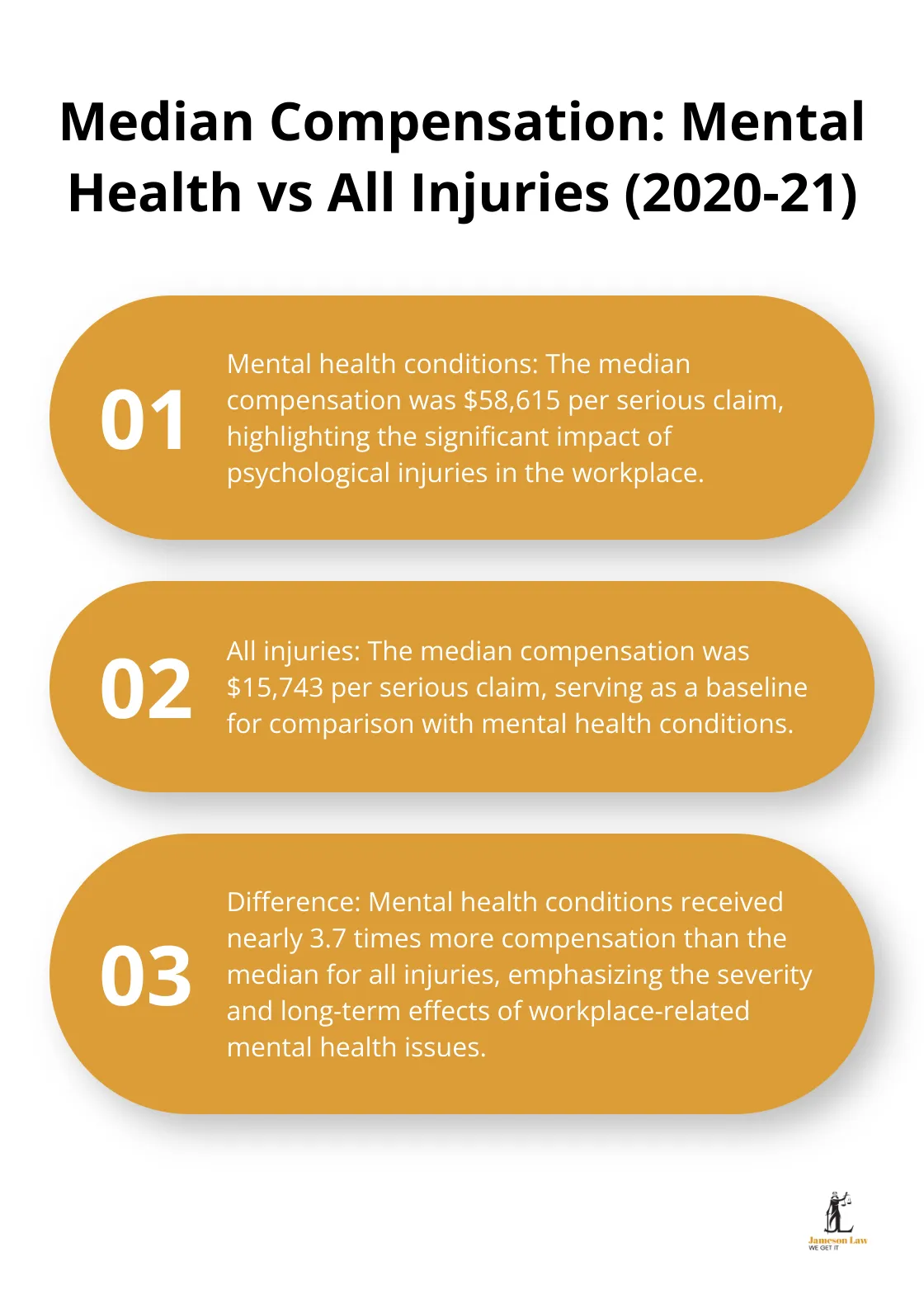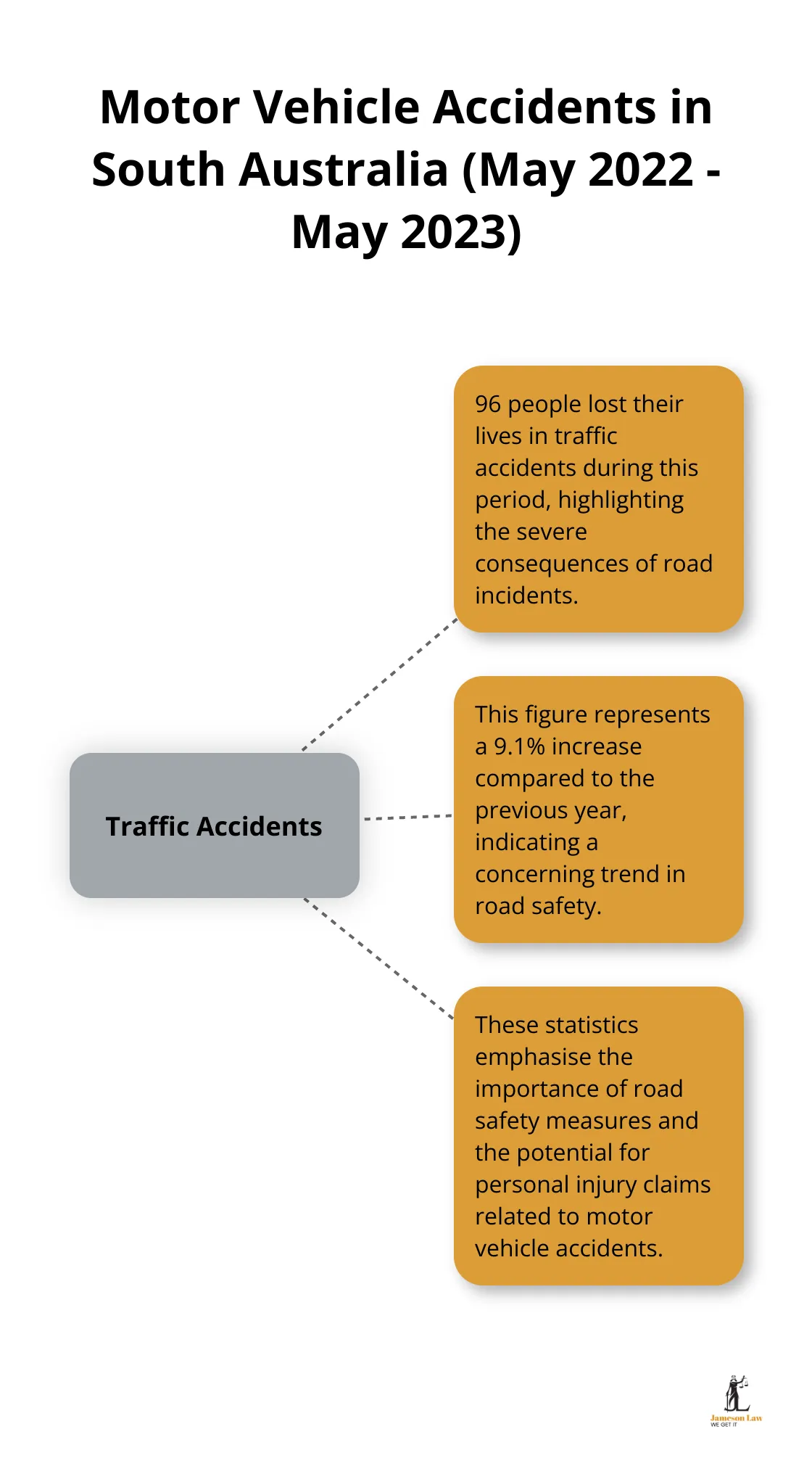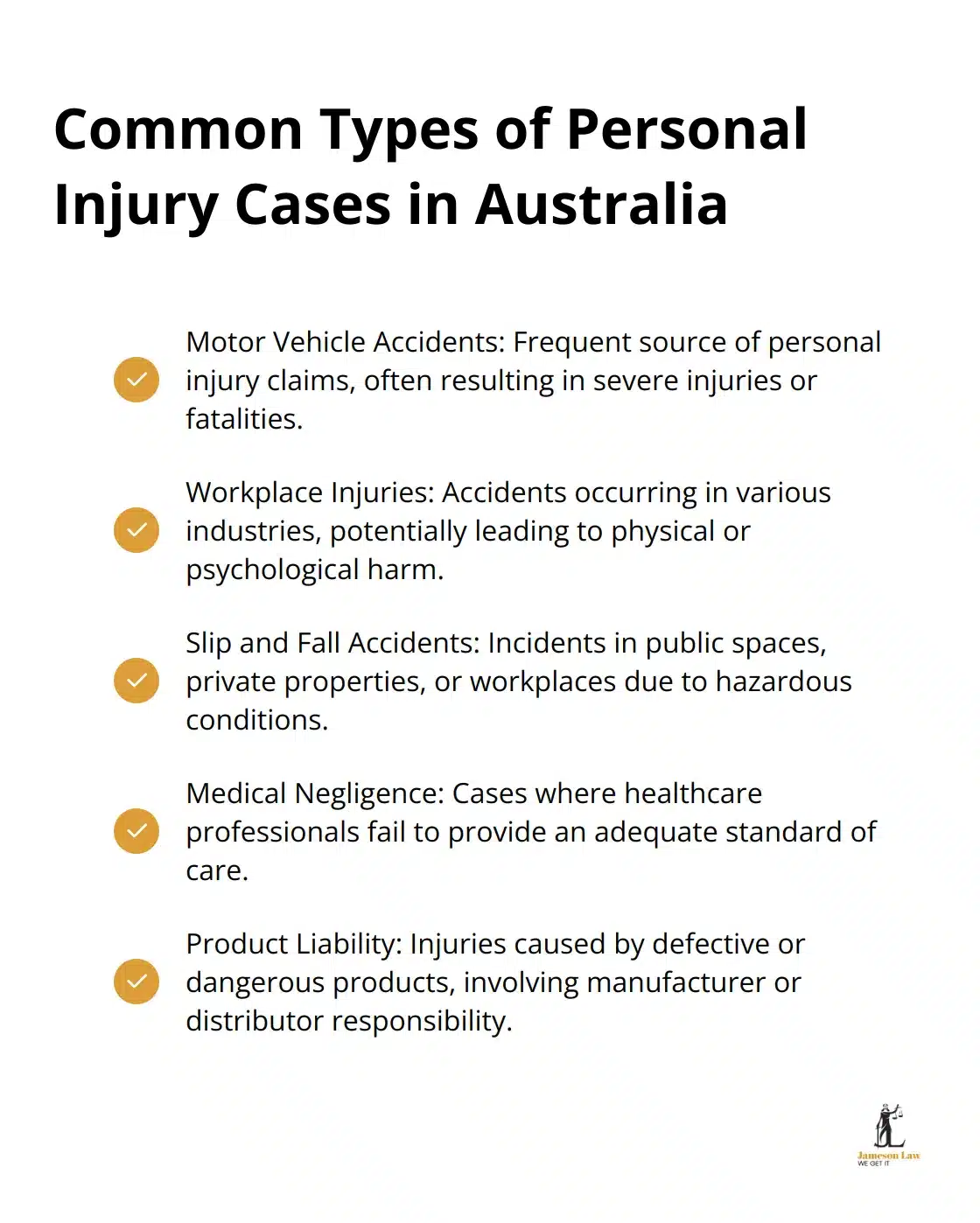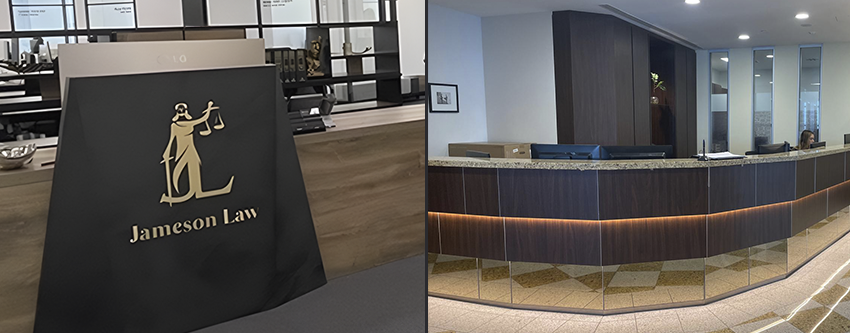Personal injury is a legal term that often confuses those unfamiliar with the law. At Jameson Law, we frequently encounter clients seeking clarity on the personal injury meaning and its implications.
Understanding the legal definition of personal injury is crucial for anyone who’s been harmed due to someone else’s negligence. This blog post will break down the concept, explore key elements of a claim, and highlight common types of personal injury cases in Australia.
What Is Personal Injury in Legal Terms?
Definition and Scope
Personal injury in legal terms can relate to a physical or psychological harm or injury. This definition encompasses a wide range of incidents, from car accidents to workplace injuries, and even cases of defamation.
In Australia, personal injury law protects individuals who have been wrongfully harmed and provides them with a means to seek compensation for their losses. The Australian Institute of Health and Welfare reported 5156 injuries that required hospitalisation among Australian rules players across all ages and both sexes in 2018/19, many of which likely resulted in personal injury claims.
Physical vs. Psychological Injuries
Personal injury law recognises both physical and psychological injuries:
- Physical injuries: These are often more straightforward to prove, as they typically involve visible wounds, broken bones, or other tangible medical conditions.
- Psychological injuries: Conditions such as post-traumatic stress disorder (PTSD) or depression resulting from an incident can be equally valid but may require more extensive documentation and expert testimony to establish.
A study by the Black Dog Institute found that approximately 5% of Australians suffer from PTSD in any given year, with many cases potentially linked to personal injury incidents. This statistic highlights the importance of considering both physical and mental health when assessing personal injury claims.
Common Types of Personal Injury Cases
Some of the most frequent personal injury cases in Australia include:
- Motor vehicle accidents: These account for a significant portion of personal injury claims.
- Workplace injuries: Safe Work Australia data shows that in 2020-21, the median compensation paid for mental health conditions was $58,615 per serious claim compared to $15,743 per serious claim for all injuries, emphasising the prevalence of workplace-related personal injuries.

- Slip and fall accidents: These can occur in public spaces, private properties, or workplaces, often due to negligent maintenance or hazardous conditions.
- Medical negligence: Cases where healthcare professionals fail to provide an adequate standard of care, resulting in harm to the patient.
- Product liability: Injuries caused by defective or dangerous products, where manufacturers or distributors may be held responsible.
Understanding the legal definition of personal injury is the first step in determining whether you have grounds for seeking compensation and what type of evidence you’ll need to support your case. With this foundation, we can now explore the key elements that constitute a valid personal injury claim.
What Makes a Valid Personal Injury Claim?
The Foundation: Duty of Care
A valid personal injury claim starts with the establishment of a duty of care. This legal obligation requires individuals to act with reasonable care to avoid harming others. Drivers owe a duty of care to other road users, and employers owe a duty of care to their employees.
In Australia, the concept of duty of care is rooted in common law and further defined by legislation such as the Civil Liability Act 2002 (NSW). Duty of care in cases of negligence in NSW can be established through the type of relationship between the claimant and the negligent party.
Proving a Breach of Duty
After establishing a duty of care, you must prove that the defendant breached this duty. This involves showing that their actions (or inactions) fell below the expected standard of care in the situation.
For example, if a driver texts while driving and causes an accident, this would likely constitute a breach of their duty of care. According to the Australian Automobile Association, distracted driving is the main contributing factor in approximately 16% of serious casualty road crashes in Australia.
The Critical Link: Causation
Causation forms the next vital element of a personal injury claim. You must demonstrate that the defendant’s breach of duty directly caused your injuries. This can prove challenging, especially in cases involving pre-existing conditions or multiple contributing factors.
In medical negligence cases, expert testimony often becomes necessary to prove that a doctor’s mistake directly led to an injury or worsened a condition. The Australian Institute of Health and Welfare reports that about 8% of hospital admissions in Australia result in an adverse event (highlighting the importance of clear causation in these cases).
Quantifying Your Losses: Damages
The final element of a personal injury claim involves damages. This refers to the losses you’ve suffered as a result of the injury. Damages can include:
- Medical expenses
- Lost wages
- Pain and suffering
- Loss of enjoyment of life
In Australia, various state and federal laws govern the assessment of damages. For example, in New South Wales, the Civil Liability Act 2002 caps certain types of damages and sets out specific criteria for assessing non-economic loss.
The average compensation payout for personal injury claims in Australia varies widely depending on the type and severity of the injury. WorkSafe Victoria reports that the average workers’ compensation claim in 2021-2022 was approximately $76,000.
Building a strong personal injury claim requires careful consideration of each of these elements. Legal professionals meticulously gather evidence and build robust arguments to support each aspect of a claim, maximising the chances of a successful outcome.
As we move forward, let’s explore the common types of personal injury cases in Australia and how they apply these fundamental elements in practice.
Common Personal Injury Cases in Australia
Personal injury cases in Australia encompass a wide range of incidents, each with distinct legal considerations. Understanding these common types can help you recognise when you might have a valid claim.
Motor Vehicle Accidents
Motor vehicle accidents top the list of frequent personal injury cases in Australia. In South Australia, 96 people lost their lives to traffic accidents between May 2022 and May 2023, an increase of 9.1% over the previous year. This statistic highlights the severity and prevalence of these incidents.

If a motor vehicle accident involves you, collect evidence immediately. Take photos of the scene, gather witness statements, and obtain a police report. These actions can significantly strengthen your claim.
Workplace Injuries
Workplace injuries form another common source of personal injury claims. Key statistics relating to high-risk industries, common injuries, and workers’ compensation claims in Australia highlight the importance of this issue.
A workplace injury requires immediate reporting to your employer and seeking medical attention. Maintain detailed records of your injury, treatment, and any time off work. These records will prove vital if you need to make a claim.
Slip and Fall Accidents
Slip and fall accidents can occur anywhere – shopping centres, footpaths, or private homes. These cases often hinge on proving the property owner’s negligence in maintaining safe conditions.
A slip and fall experience requires you to document the hazard that caused your fall. Take photos if possible, and report the incident to the property owner or manager. Seek medical attention promptly (even if your injuries seem minor at first).
Medical Negligence
Medical negligence cases present complex and often emotionally charged situations. While specific statistics are not available, the potential scale of the issue remains significant.
Suspicion of medical negligence requires you to obtain copies of all your medical records. Seek a second opinion from another healthcare professional. Time limits for medical negligence claims can be strict, so consult a legal professional promptly.
Product Liability
Product liability cases arise when a defective product causes injury. These can range from faulty appliances to contaminated food products. The Australian Competition and Consumer Commission (ACCC) recalls hundreds of products each year due to safety concerns.
An injury from a product requires you to preserve the product and its packaging (if possible). Keep any receipts or proof of purchase. Document your injuries and any medical treatment received. This evidence can prove crucial in establishing your claim.

Final Thoughts
The personal injury meaning encompasses physical and psychological harm caused by another’s negligence. Personal injury law in Australia provides a framework for seeking compensation, but navigating this complex legal landscape requires proper guidance. A skilled lawyer can help you understand your rights, assess your claim’s strength, and guide you through legal procedures.
At Jameson Law, we specialise in personal injury cases and offer expert legal services across Australia. Our team handles a wide range of personal injury claims, from motor vehicle accidents to workplace injuries and medical negligence cases. We offer a No Win No Fee policy for plaintiff personal injury claims, making our services accessible to those who need them most.
Time limits apply to personal injury claims in Australia, so prompt action is important. If you’ve suffered a personal injury, don’t hesitate to seek professional legal advice. With the right support, you can navigate the complexities of personal injury law and work towards a fair resolution for your case.













